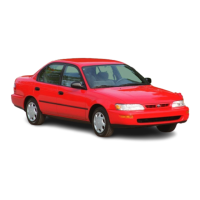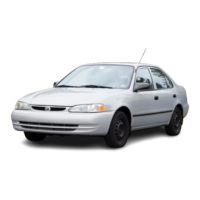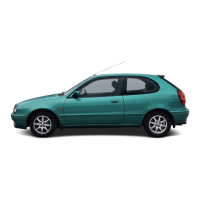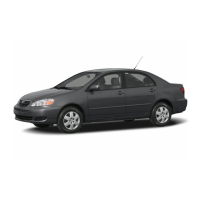Do you have a question about the Toyota Corolla 1997 and is the answer not in the manual?
Provides an overview of the vehicle's dashboard layout, instruments, and controls.
Covers the operation and security features related to vehicle keys and doors.
Provides essential information and precautions regarding the proper use of seat belts.
Explains the function and deployment conditions of the Supplemental Restraint System airbags.
Emphasizes the importance of child restraint systems and provides precautions for their use.
Details the features and operation of the vehicle's integrated child restraint system.
Covers the operation of all exterior and interior lights, wipers, and defogger systems.
Explains various gauges, meters, and warning indicators for vehicle status.
Explains the meaning of various service reminder lights and buzzers.
Discusses the brake system warning light, including parking brake and low fluid level alerts.
Details the seat belt reminder system and its operation.
Explains the function of the discharge warning light related to the charging system.
Covers the low oil pressure warning light and actions to take if it illuminates.
Explains the low fuel level warning light and when to refuel.
Discusses the ABS warning light and its indications of system status.
Details the SRS airbag warning light and what it indicates about the airbag system.
Describes the malfunction indicator lamp and its causes.
Explains the ignition switch operation, transmission types, and parking brake usage.
Explains how to operate and set the vehicle's cruise control system.
Details fuel types, octane ratings, and tank capacity recommendations.
Explains the tandem master cylinder and brake booster systems.
Step-by-step procedures for starting the engine, including manual and automatic transmissions.
Outlines basic troubleshooting steps for a vehicle that fails to start.
Procedures to follow if the engine stalls while the vehicle is in motion.
Steps to take and precautions when the vehicle's engine overheats.
Comprehensive guide on how to safely change a flat tire.
Information and precautions for towing the vehicle, including when professional service is recommended.
Procedures and critical safety advice for emergency towing situations.
Overview of vehicle maintenance requirements and general care practices.
Lists routine checks and maintenance tasks that owners can perform.
Provides clues and symptoms that may indicate the need for vehicle repair.
Critical safety warnings and precautions for performing DIY maintenance.
Covers battery condition checks, recharging, fuses, washer fluid, and light bulbs.
Safety warnings and emergency measures related to battery handling.
Guidance on how to check for blown fuses and replace them correctly.
Technical specifications for various vehicle systems like engine, clutch, brakes, etc.
Information on how to report vehicle safety defects to NHTSA and Toyota.
Provides an overview of the vehicle's dashboard layout, instruments, and controls.
Covers the operation and security features related to vehicle keys and doors.
Provides essential information and precautions regarding the proper use of seat belts.
Explains the function and deployment conditions of the Supplemental Restraint System airbags.
Emphasizes the importance of child restraint systems and provides precautions for their use.
Details the features and operation of the vehicle's integrated child restraint system.
Covers the operation of all exterior and interior lights, wipers, and defogger systems.
Explains various gauges, meters, and warning indicators for vehicle status.
Explains the meaning of various service reminder lights and buzzers.
Discusses the brake system warning light, including parking brake and low fluid level alerts.
Details the seat belt reminder system and its operation.
Explains the function of the discharge warning light related to the charging system.
Covers the low oil pressure warning light and actions to take if it illuminates.
Explains the low fuel level warning light and when to refuel.
Discusses the ABS warning light and its indications of system status.
Details the SRS airbag warning light and what it indicates about the airbag system.
Describes the malfunction indicator lamp and its causes.
Explains the ignition switch operation, transmission types, and parking brake usage.
Explains how to operate and set the vehicle's cruise control system.
Details fuel types, octane ratings, and tank capacity recommendations.
Explains the tandem master cylinder and brake booster systems.
Step-by-step procedures for starting the engine, including manual and automatic transmissions.
Outlines basic troubleshooting steps for a vehicle that fails to start.
Procedures to follow if the engine stalls while the vehicle is in motion.
Steps to take and precautions when the vehicle's engine overheats.
Comprehensive guide on how to safely change a flat tire.
Information and precautions for towing the vehicle, including when professional service is recommended.
Procedures and critical safety advice for emergency towing situations.
Overview of vehicle maintenance requirements and general care practices.
Lists routine checks and maintenance tasks that owners can perform.
Provides clues and symptoms that may indicate the need for vehicle repair.
Critical safety warnings and precautions for performing DIY maintenance.
Covers battery condition checks, recharging, fuses, washer fluid, and light bulbs.
Safety warnings and emergency measures related to battery handling.
Guidance on how to check for blown fuses and replace them correctly.
Technical specifications for various vehicle systems like engine, clutch, brakes, etc.
Information on how to report vehicle safety defects to NHTSA and Toyota.
| Brand | Toyota |
|---|---|
| Model | Corolla 1997 |
| Category | Automobile |
| Language | English |











